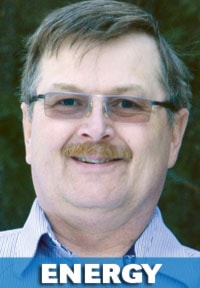Imagine a beautiful day, blue sky, the wind at a steady 18 km/h, the wind turbine rotating in the breeze, the solar array tracking the sun as it treks across the horizon.
You go out to your electric car, unplug it from the charger where it has been plugged in awaiting the start of your morning.
Off to town you go, noiselessly accelerating at a rate that scares the piston-driven crowd and leaves them sitting at the light.
Sound farfetched?
Well No. 1, you probably are not going to see this in Alberta any time soon, but the technology is available and is being used.
Alternate energy systems have proven themselves in industrial situations all over the world. From large solar farms in California to the wind farms in Alberta, the green energy concept is being verified daily.
Electrical energy can only replace so much infrastructure.
In the alternative fuel side, hydrogen is one avenue being aggressively pursued, especially by countries with no petroleum resource.
Fuel cells, the newest user of hydrogen, are moving into their place.
They have been around awhile, actually having been invented in 1839 by Sir William Grove. The ability to generate hydrogen has been around since 1766 when Henry Cavendish recognized it as a “discrete substance.”
It is feasible to set up an off-grid home, with wind and solar arrays large enough to generate a surplus of power on those clear, windy days.
This energy surplus could be used to produce hydrogen, store the hydrogen in metal hydride cylinders, and use it for running fuel cells to power the house on foggy days, heating your home, cooking your food and even, running your hybrid vehicle.
Alternatively, electric vehicles could be used to provide your basic transportation needs, totally eliminating the use of hydrocarbons.
This would significantly reduce your carbon footprint, your cost of transportation and maintenance.
Essentially, a properly designed alternate energy system would provide you everything you needed to maintain the standard of living that we have become so accustomed to.
In addition, it would reduce the consumption of non-renewable resources and would greatly ease your personal impact on the environment.
Practical applications would be remote facilities like fishing lodges, new homes where bringing in the grid is extremely costly, or geographically not possible. Basically anywhere you have to be or want to be, totally self sufficient.
Proof of concept: there are actually hydrogen homes already in operation that harvest enough of an excess of power that electricity, heating, and fuel for local transportation are provided for.
However, this takes the kind of dedication to a new concept that most people are not willing to muster.
This equipment may not be sitting on the shelf down at the hardware and it also takes a certain amount of technical expertise and talent to install and operate.
For some, that is reason enough not to proceed with the concept, for others the seed of a very important idea has been planted.
I like the fact we have a choice.
Lorne Oja is an energy consultant, power engineer and a partner in a company that installs solar panels, wind turbines and energy control products in Central Alberta. He built his first off-grid home in 2003 and is in the planning stage for his second. His column appears every second Friday in the Advocate. Contact him at: lorne@solartechnical.ca.
